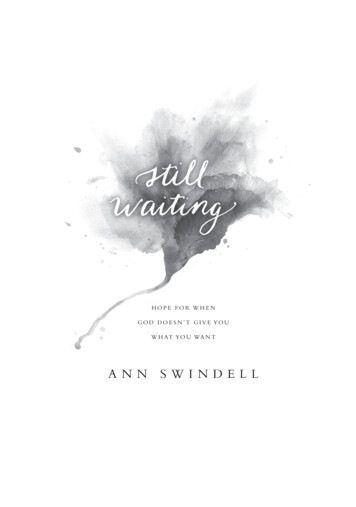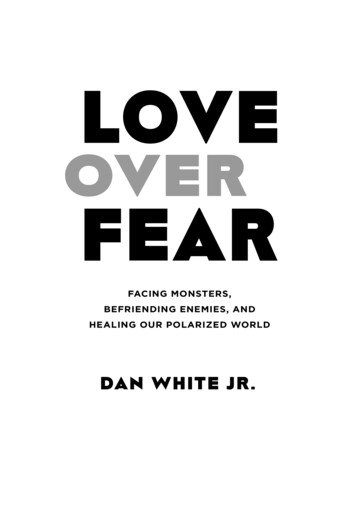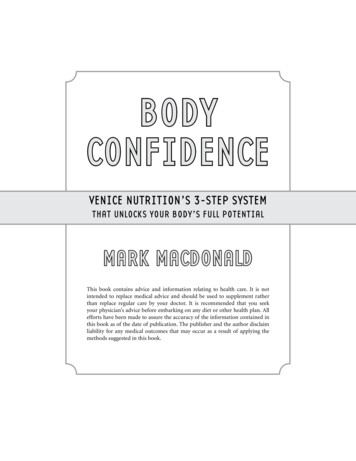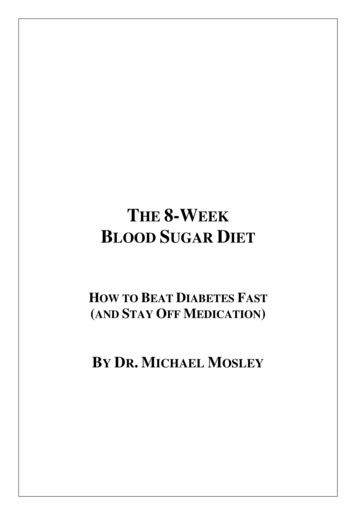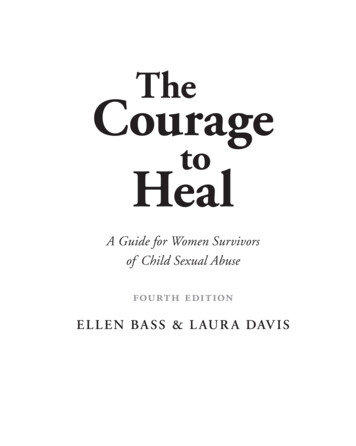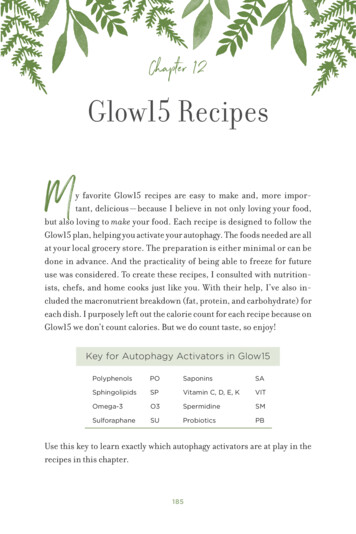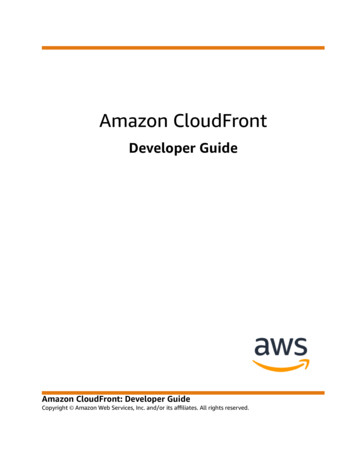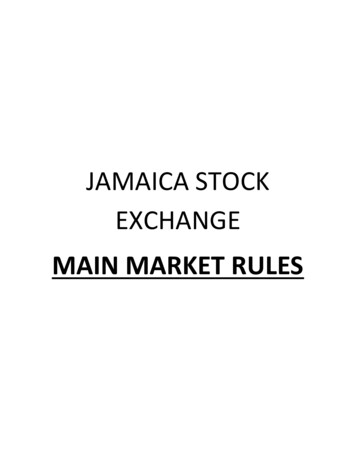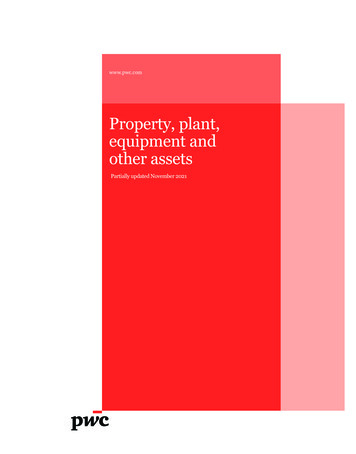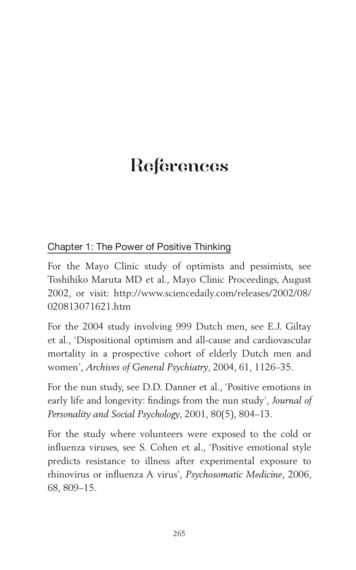
Transcription
ReferencesChapter 1: The Power of Positive ThinkingFor the Mayo Clinic study of optimists and pessimists, seeToshihiko Maruta MD et al., Mayo Clinic Proceedings, August2002, or visit: 3071621.htmFor the 2004 study involving 999 Dutch men, see E.J. Giltayet al., ‘Dispositional optimism and all-cause and cardiovascularmortality in a prospective cohort of elderly Dutch men andwomen’, Archives of General Psychiatry, 2004, 61, 1126–35.For the nun study, see D.D. Danner et al., ‘Positive emotions inearly life and longevity: findings from the nun study’, Journal ofPersonality and Social Psychology, 2001, 80(5), 804–13.For the study where volunteers were exposed to the cold orinfluenza viruses, see S. Cohen et al., ‘Positive emotional stylepredicts resistance to illness after experimental exposure torhinovirus or influenza A virus’, Psychosomatic Medicine, 2006,68, 809–15.265
How Your Mind Can Heal Your BodyFor an article containing the study of 200 telecommunicationsexecutives, see Peggy Rynk, ‘The value of a healthy attitude: howfaith, anger, humor, and boredom can affect your health’, VibrantLife, March–April 2003.For the study of 586 people finding that attitude is the bestprevention against heart disease, see D.M. Becker, ‘Positiveattitude is best prevention against heart disease’, paper presentedat the American Heart Association Annual Scientific Sessions,Anaheim, CA, 12 November 2001. To read an account of thestudy, visit: http://www.hopkinshospital.org/health info/Heart/Reading/positive attitudeFor the study of 866 heart patients and positive attitude, seeB. Brummett, ‘Positive outlook linked to longer life in heartpatients’, paper presented at the American PsychosomaticSociety, March 2003. To read an account of the study, visit:http://dukemednews.org/av/medminute.php?id 6511For the emotional vitality study, see L.D. Kubzansky and R.C.Thurston, ‘Emotional vitality and incident coronary heartdisease: benefits of healthy psychological functioning’, Archivesof General Psychiatry, 2007, 64(12), 1393–1401.For the ‘Hard Marriage, Hard Heart’ research, see: T.W. Smith et al., ‘Marital conflict behavior and coronaryartery calcification’, paper presented at the AmericanPsychosomatic Society 64th Annual Meeting, Denver, CO,3 March 2006. T.W. Smith et al., ‘Hostile personality traits and coronaryartery calcification in middle-aged and older married couples:different effects for self-reports versus spouse ratings’,Psychosomatic Medicine, 2007, 69(5), 441–48.266
References P. Pearsall, ‘Contextual cardiology: what modern medicinecan learn from ancient Hawaiian wisdom’, Cleveland ClinicalJournal of Medicine, 2007, 74(1), S99–S104.For the 25-year hostility study, see J.C. Barefoot et al., ‘Hostility,CHD incidence, and total mortality: A 25-year follow-upstudy of 255 physicians’, Psychosomatic Medicine, 1983, 45(1),59–63.For the paper quoting hostility as an indicator of heart disease, seeR.B. Williams et al., ‘Psychosocial risk factors for cardiovasculardisease: more than one culprit at work’, Journal of the AmericanMedical Association, 2003, 290(16), 2190–92.For the Finnish satisfaction study, see H. Koivumaa-Honkanenet al., ‘Self-reported life satisfaction and 20-year mortality inhealthy Finnish adults’, American Journal of Epidemiology, 2000,152(10), 983–91.For the ‘Money buys happiness’ research, see Elizabeth Dunn,‘Money buys happiness when you spend on others: UBC andHarvard research’, University of British Columbia Media Release,20 March 2008. To view the media release, visit: 8/mr-08-032.htmlFor the effect of attitude on aging, see B.R. Levy et al., ‘Longevityincreased by positive self-perceptions of aging’, Journal ofPersonality and Social Psychology, 2002, 83(2), 261–70.For the study of positive attitude being good for blood pressure,see G.V. Ostir et al., ‘Hypertension in older adults and the roleof positive emotions’, Psychosomatic Medicine, 2006, 68, 727–33.For the study linking frailty with attitude, see G.V. Ostir et al.,‘Onset of frailty in older adults and the protective role of positiveaffect’, Psychology and Aging, 2004, 19(3), 402–08.267
How Your Mind Can Heal Your BodyFor the link between life satisfaction and longevity, see T.M.Lyyra et al., ‘Satisfaction with present life predicts survival inoctogenarians’, The Journals of Gerentology Series B: PsychologicalSciences and Social Sciences, 2006, 61, 319–26.For the Posit Science Corporation study, see: H.W. Mahncke et al., ‘Memory enhancement in healthyolder adults using a brain plasticity-based training program:a randomized, controlled study’, Proceedings of the NationalAcademy of Sciences, USA, 2006, 103(33), 12523–28. H.W. Mahncke et al., ‘Brain plasticity and functional losses inthe aged: scientific basis for a novel intervention’, Progress inBrain Research, 2006, 157, 81–109.For the Harvard age study going back to 1959, see Ellen J. LangerPhD, Mindfulness (Da Capo Press, 1990).For information on using the brain and reducing the risk ofAlzheimer’s, see R.S. Wilson et al., ‘Participation in cognitivelystimulating activities and risk of incident Alzheimer’s disease’,Journal of the American Medical Association, 2002, 287(6), 742–48.For the priming experiments, see: J.A. Bargh et al., ‘Automaticity of social behavior: direct effectsof trait construct and stereotype activation on action’, Journalof Personality and Social Psychology, 1996, 71(2), 230–44. T.M. Hess et al., ‘Explicit and implicit stereotype activationeffects on memory: do age and awareness moderate the impactof priming?’, Psychology and Aging, 2004, 19(3), 495–505.Chapter 2: The Power of BelievingThe quotation from Professor Benedetti can be found in F.Benedetti, ‘Mechanisms of placebo and placebo-related effects268
Referencesacross diseases and treatments’, Annual Review of Pharmacologyand Toxicology, 2008, 46, 33–60. This is also a good review ofrecent research into the placebo effect.For the release of dopamine when Parkinson’s patients receiveplacebos, see: R. de la Fuente-Fernández et al., ‘Expectation and dopaminerelease: mechanism of the placebo effect in Parkinson’sdisease’, Science, 2001, 293(5532), 1164–66. R. de la Fuente-Fernández et al., ‘Dopamine release in humanventral striatum and expectation of reward’, Behavioral BrainResearch, 2002, 136(2), 359–63.The first evidence of opioid release during placebo analgesiacan be found in J.D. Levine et al., ‘The mechanism of placeboanalgesia’, Lancet, 1978, 654–57.For an account of placebo effects tracking closely the treatmentswith which they’re paired, and a discussion of the similarityin brain scans while patients receive Prozac or a placebo, seeF. Benedetti et al., ‘Neurobiological mechanisms of the placeboeffect’, Journal of Neuroscience, 2005, 25(45), 10390–402.For the MRI brain scans of people receiving placebos and highplacebo responses, see: J.K. Zubieta et al., ‘Placebo effects mediated by endogenousopioid activity on m-opioid receptors’, Journal of Neuroscience,2005, 25, 7754–62. T.D. Wager et al., ‘Placebo effects on human m-opioid activityduring pain’, Proceedings of the National Academy of Sciences,USA, 2007, 104(26), 11056–61.For some clinical trial results, visit: /trial-results/ (last accessed, 5th June 2018).269
How Your Mind Can Heal Your BodyFor the chronic fatigue syndrome study that tested acyclovir, seeS.E. Strauss et al., ‘Acyclovir treatment of the chronic fatiguesyndrome. Lack of efficacy in a placebo-controlled trial’, NewEngland Journal of Medicine, 1988, 319(26), 1692–98.For the placebo studies on asthma, see: T. Luparello et al., ‘Influences of suggestion on airway reactivityin asthmatic subjects’, Psychosomatic Medicine, 1969, XXX,819–25. E.R. McFadden et al.,‘The mechanism of action of suggestionin the induction of acute asthma attacks’, PsychosomaticMedicine, 1969, XXXI, 134–43.For the study of performance-enhancing placebos, see F. Benedettiet al., ‘Opioid-mediated placebo responses boost pain enduranceand physical performance: is it doping in sport competitions?’Journal of Neuroscience, 2007, 27(44), 11934–39.For the study involving the hotel-room maids, see A. J. Crum andE. J. Langer, Psychological Science, 2007, 18(2), 165-171.For the study of women’s beliefs affecting their mathematicsperformance, see I. DarNimrod and S.J. Heine, ‘Exposure toscientific theories affects women’s math performance’, Science,2006, 314(5798), 435.For information on placebo responders, as well as lots ofinformation on a range of placebo studies, see Daniel Moerman,Meaning, Medicine and the ‘Placebo Effect’ (Cambridge UniversityPress, 2002).The 1954 bleeding ulcers study was reported in DanielMoerman’s book.For the study involving hidden arm pain, see F. Benedetti, ‘Theopposite effects of the opiate antagonist naloxone and the270
Referencescholecystokinin antagonist proglumide on placebo analgesia’,Pain, 1996, 64(3), 535–43.For the dental injections given with an ‘oversell’ or ‘undersell’message, see S.L. Gryll and M. Katahn, ‘Situational factorscontributing to the placebo effect’, Psychopharmacology, 1978,57(3), 253–61.For the study on the effect of positive and negative consultations,see K.B. Thomas, ‘General practice consultations: is there anypoint in being positive?’ British Medical Journal, 1987, 294,1200–02.For the studies of optimists and pessimists and how they respondin the placebo effect, see the following: For the pessimists study, see A.L. Geers et al., ‘Reconsideringthe role of personality in placebo effects: dispositionaloptimism, situational expectations, and the placebo response’,Journal of Psychosomatic Research, 2005, 58(2), 212–17. For the optimists study, see A.L. Geers et al., ‘Furtherevidence for individual differences in placebo responding:an interactionist perspective’, Psychosomatic Research, 2007,62(5), 563–70.For the conditioned immunosuppression using cyclosporin A,see M. U. Goebel et al., ‘Behavioral conditioning ofimmunosuppression is possible in humans’, FASEB Journal,2002, 16, 1869–73.For Benedetti’s conditioning of immune and growth hormonelevels, see F. Benedetti et al., ‘Conscious expectation andunconscious conditioning in analgesic, motor, and hormonalplacebo/nocebo responses’, Journal of Neuroscience, 2002, 23,4315–23.271
How Your Mind Can Heal Your BodyFor the Benedetti study where Parkinson’s patients receivedplacebos instead of apomorphine, see F. Benedetti et al., ‘TeachingNeurons to Respond to Placebos’, Journal of Physiology, 2016,594(19), 5647-5660For PCDR studies and a discussion on how to use conditioningto boost the placebo effect, see Jo Marchant, Cure (CannongateBooks, London, 2017), chapter 3, ‘Pavlov’s Power’.Chapter 3: Drugs Work Better If We Believe in ThemFor the 2008 antidepressants analysis that found over 80 percent placebo effect, see I. Kirsch et al., ‘Initial severity andantidepressant benefits: a meta-analysis of data submitted to thefood and drug administration’, PLoS Medicine, February 2008,5(2), e45, 0260–68.A number of the studies reported in this chapter were also citedin Daniel Moerman’s excellent book, cited above. I thoroughlyrecommend it to anyone seeking a fuller understanding of theplacebo effect and its implications.For the quote from C.G. Helman, see his chapter entitled ‘Placebosand nocebos: the cultural construction of belief’ in Understandingthe Placebo Effect in Complementary Medicine, Theory, Practice andResearch, ed. D. Peters (Churchill Livingstone, 2001).For the study of blue and pink sedatives and stimulants, seeB. Blackwell et al., ‘Demonstration to medical students ofplacebo responses and non-drug factors’, Lancet, 1972, 1(7763),1279–82.For the study of injections versus tablets in the USA and Europe,see A.J. de Craen et al., ‘Placebo effect in the acute treatment ofmigraine: subcutaneous placebos are better than oral placebos’,Journal of Neurology, 2000, 247(3), 183–88.272
ReferencesFor the study of Tagamet performed in France, see R. Lambertet al., ‘Treatment of duodenal and gastric ulcer with cimetidine.A multicenter double-blind trial’, Gastroenterologie Clinique etBiologique, 1977, 1(11), 855–60.For the study in Brazil, see J.A. Salgado et al., ‘Endoscopicfindings after antacid, cimetidine and placebo for peptic ulcer –importance of staging the lesions’, Arquivos De Gastroenterologia,1981, 18(2), 51–3. Both studies are reported in Daniel Moerman’sbook, cited above.The reduction in effectiveness of Tagamet once Zantac was availableis described in Damiel Moerman’s book. It’s also mentioned inHerbert Benson MD’s Timeless Healing (Scribner, 1995).For the University of Keel aspirin study, see A. Branthwaiteand P. Cooper, ‘Analgesic effects of branding in treatment ofheadaches’, British Medical Journal, 1981, 282, 1576–78.For the suggestion that Viagra is enhanced by its name, seeA.K. Vallance, ‘Something out of nothing: the placebo effect’,Advances in Psychiatric Treatment, 2006, 12, 287–96.For the study of four placebos being better than two in anti-ulcertrials, see A.J. de Craen et al., ‘Placebo effect in the treatment ofduodenal ulcer’, British Journal of Clinical Pharmacology, 1999,48(6), 853–60.For adherence in the clofibrate trial, see Coronary Drug ProjectResearch Group, ‘Influence of adherence to treatment andresponse of cholesterol on mortality in the coronary drug project’,New England Journal of Medicine, 1980, 303(18), 1038–41.For the real versus sham mammary ligation studies, see: E.G. Dimond et al., ‘Comparison of internal mammary arteryligation and sham operation for angina pectoris’, AmericanJournal of Cardiology, 1960, 5, 483–86.273
How Your Mind Can Heal Your Body L.A. Cobb et al., ‘An evaluation of internal-mammary-arteryligation by a double-blind technique’, New England Journal ofMedicine, 1959, 260(22), 1115–18.For the summary analysis of 53 trials comparing actual surgerywith sham surgery, see K. Wartolowska et al., ‘Use of placebocontrols in the evaluation of surgery: Systematic review’, BritishMedical Journal, 2014, 348, g3253.For the naproxen study where patients either knew or didn’tknow that they were receiving it, see J.F. Bergmann et al., ‘Arandomised clinical trial of the effect of informed consent onthe analgesic activity of placebo and naproxen in cancer pain’,Clinical Trials Meta-Analysis, 1994, 29(1), 41–7.For research showing that a placebo can be as good as 6–8mgof morphine, see J.D. Levine and N.C. Gordon, ‘Influence of themethod of drug administration on analgesic response’, Nature,1984, 312, 755.For research showing that diazepam doesn’t work unless aperson knows they’re receiving it, see F. Benedetti et al., ‘Hiddenadministration of drugs’, Clinical Pharmacology & Therapeutics,2011, 90, 651–661.The Benedetti quote, ‘The existence of the placebo effect suggeststhat we must broaden our conception of the limits of humancapability,’ can be found in F. Benedetti et al., ‘Neurobiologicalmechanisms of the placebo effect’, Journal of Neuroscience, 2005,25(45), 10390–402.For research showing that open label placebos work throughnonconscious processes, see: K.B. Jensen et al., ‘A neuralmechanism for nonconscious activation of conditionedplacebo and nocebo responses’, Cerebral Cortex, 2015, 25, 3903–3910.274
ReferencesFor the OLP study on IBS, see: T.J. Kaptchuk et al., ‘PlacebosWithout Deception: A randomized controlled trial in irritablebowel syndrome’, PLoS ONE, 2010, 5(12), e15591.For the OLP study on chronic low back pain, see: C. Carvalhoet al., ‘Open-label Placebo Treatment in Chronic Low Back Pain:A randomized controlled trial’, Pain, 2016, 157(12), 2766 –2772.For the OLP study on fatigue suffered by cancer patients, see:T.W. Hoenemeyer et al., ‘Open-Label Placebo Treatment forCancer-Related Fatigue: A Randomized-Controlled ClinicalTrial’, Scientific Reports, 2018, 8(2784), 1–8.Chapter 4: The Power of PlasticityFor the study of brain changes in symphony musicians, see V.Sluming et al., ‘Voxel-based morphometry reveals increasedgray matter density in Broca’s area in male symphony orchestramusicians’, NeuroImage, 2002, 17(3), 1613–22.The reference to brain-map changes as blind people learn Braillecan be found in Norman Doidge MD, The Brain That ChangesItself (Penguin, 2007).For the study of brain changes while students were studying forexams, see B. Draganski et al., ‘Temporal and spatial dynamicsof brain structure changes during extensive learning’, Journal ofNeuroscience, 2006, 26(23), 6314–17.For the London taxi drivers study, see E.A. Maguire et al.,‘London taxi drivers and bus drivers: a structural MRI andneuropsychological analysis’, Hippocampus, 2006, 16, 1091–101.For the study showing brain changes in mathematicians, see K.Aydin et al., ‘Increased gray matter density in the parietal cortex275
How Your Mind Can Heal Your Bodyof mathematicians: a voxel-based morphometry study’, AmericanJournal of Neuroradiology, 2007, 28(10), 1859–64.For the study of the effects of meditation on the brain, see S.W.Lazar et al., ‘Meditation experience is associated with increasedcortical thickness’, Neuroreport, 2005, 16(17), 1893–97.The Eric Kandel quote, as well as a discussion of brain changesdue to psychotherapy, can be found in Norman Doidge’s book,cited above.For the study showing 15 per cent increase in hippocampalvolume due to environmental enrichment, see G. Kempermanet al., ‘Neuroplasticity in old age: sustained fivefold inductionof hippocampal neurogenesis by long-term environmentalenrichment’, Annals of Neurology, 2002, 52, 135–143. See alsoL. Lu et al., ‘Modification of hippocampal neurogenesis andneuroplasticity by social environments’, Experimental Neurology,2003, 183(2), 600–09.For discovery of neurogenesis in the hippocampus, see P.S.Eriksson et al., ‘Neurogenesis in the adult human hippocampus’,Nature Medicine, 1998, 4(11), 1313–17.The identification of neurogenesis right up to our final days canbe found in the paper cited immediately above, on the discoveryof neurogenesis in adults. The scientists received permissionfrom terminally ill patients to inject them with a biologicalmarker, bromodeoxyuridine (BrdU). When the patients died,neurogenesis was discovered.For a good review of neurogenesis, see P. Taupin and F.H. Gage,‘Adult neurogenesis and neural stem cells of the central nervoussystem in mammals’, Journal of Neuroscience Research, 2002, 69,745–49.276
ReferencesChapter 5: The Mind Can Heal the BodyFor a good description of the brain and how it changes withour thoughts and emotions, see Joe Dispenza, Evolve Your Brain(Health Communications Inc., 2007).For the research showing that hostility slows the rate of woundhealing, see J.K. Kiecolt-Glaser et al., ‘Hostile marital interactions,proinflammatory cytokine production, and wound healing’,Archives of General Psychiatry, 2005, 62(12), 1377–84.For the effects of stress on growth hormone levels and on the‘upregulation’ and ‘downregulation’ of genes at wound sites, seeS. Roy, et al., ‘Wound site neutrophil transcriptome in responseto psychological stress in young men’, Gene Expression, 2005,12(4–6), 273–87.For social support speeding up wound healing, see C.E.Detillion et al.,‘Social facilitation of wound healing’,Psychoneuroendocrinology, 2004, 29(8), 1004–11.Trumping our genes refers to the science of epigenetics. To learnmore about epigenetics, see Bruce Lipton, The Biology of Belief(Mountain of Love/Elite Books, 2005). See also Dawson Church,The Genie in Your Genes (Elite Books, 2007).For research on the effect of love and care on the growth ofchildren, see David R. Hamilton PhD, Why Kindness is Good forYou (Hay House, London, 2010), Chapter 10, ‘Why Babies NeedLove’. See also: www.bucharestearlyinterventionproject.org (lastaccessed 23 May 2018).For information on neurogenesis and the suggestion that themind interacts with DNA in stem cells, see Ernest L. Rossi, ThePsychobiology of Gene Expression (Norton, 2002).277
How Your Mind Can Heal Your BodyChapter 6: The Power of Imagination and ObservationFor the Benedetti study involving capsaicin, see F. Benedettiet al., ‘Somatotopic activation of opioid systems by targetdirected expectations of analgesia’, The Journal of Neuroscience,1999, 19(9), 3639–48.For the study where experimental pain was induced in fingers,see G. Montgomery and I. Kirsch, ‘Mechanisms of placebo painreduction: an empirical investigation’, Psychological Science,1996, 7(3), 174–76.In an email communication, I asked Fabrizio Benedetti whethera person with two different ailments would get better from oneof them if he or she was given a placebo for that specific ailment(believing it to be a real drug) but not the other. Would a personwith Parkinson’s, say, who also had a headache and who receivedan anti-Parkinson’s drug (which was really a placebo) find thetremors reducing but not the headache, and vice versa? Benedettiagreed that this would most likely be the case.For the Karolinska Institute research showing that imaginedmovements of fingers, toes and tongue activated brain regionsthat governed them, see H. H. Ehrsson et al., ‘Imagery ofvoluntary movement of fingers, toes, and tongue activatescorresponding body-part-specific motor representations’, Journalof Neurophysiology, 2003, 90(5), 3304–16.For the piano study, see A. Pascual-Leone et al., ‘Modulation ofmuscle responses evoked by transcranial magnetic stimulationduring the acquisition of new fine motor skills’, Journal ofNeurophysiology, 1995, 74(3), 1037–45.For the study where volunteers’ fingers got 35 per cent strongerthrough imagined training, see V.K. Ranganathan et al., ‘Frommental power to muscle power – gaining strength by using the278
Referencesmind’, Neuropsychologia, 2004, 42(7), 944–56. See also G. Yueand K.J. Cole, ‘Strength increases from the motor program:comparison of training with maximal voluntary and imaginedmuscle contractions’, Journal of Neurophysiology, 1992, 67(5),1114–23.For the study showing the differences in muscle activationdepending upon the imagined weight, see A. Guillot et al.,‘Muscular responses during motor imagery as a function of musclecontraction types’, International Journal of Psychophysiology,2007, 66(1), 18–27.For the study where the tetraplegic person opened an email withhis mind, see L.R. Hochberg et al., ‘Neuronal ensemble controlof prosthetic devices by a human with tetraplegia’, Nature, 2006,442, 164–71.For research into mental walking in virtual-reality simulators, seeG. Pfurtscheller, et al., ‘Walking from thought’, Brain Research,2006, 1071(1), 145–52.For mirror neurons research where volunteers watched hands,mouth or foot movements, see G. Buccino et al., ‘Actionobservation activates premotor and parietal areas in a somatotopicmanner: an fMRI study’, European Journal of Neuroscience, 2001,13(2), 400–04.For the ‘Bend it like Beckham’ paper, see P. Bach and S.P Tipper,‘Bend it like Beckham: embodying the motor skills of famousathletes’, Quarterly Journal of Experimental Psychology, 2006,59(12), 2033–39.For the study where volunteers increased finger strength throughwatching training, see C.A. Porro et al., ‘Enhancement of forceafter action observation: behavioural and neurophysiologicalstudies’, Neuropsychologia, 2007, 45(13), 3114–21.279
How Your Mind Can Heal Your BodyFor improvements gained by stroke patients through watchingpeople perform routine actions, see D. Ertelt et al., ‘Actionobservation has a positive impact on rehabilitation of motordeficits after stroke’, NeuroImage, 2007, 36, Supplement 2,T164–73.For activation of mirror neurons while watching someoneplaying a guitar, see G. Buccino et al., ‘Neural circuits underlyingimitation learning of hand actions: an event-related fMRI study’,Neuron, 2004, 42, 323–34.For activation of the brain by listening to sentences describingmotion, see G. Buccino et al., ‘Listening to action-relatedsentences modulates the activity of the motor system: acombined TMS and behavioral study’, Cognitive Brain Research,2005, 24(3), 355–63.See also M. Tettamanti et al., ‘Listening to action-relatedsentences activates fronto-parietal motor circuits’, Journal ofCognitive Neuroscience, 2005, 17(2), 273–81.For activation of tongue muscles by listening to speech, seeL. Fadiga et al., ‘Speech listening specifically modulates theexcitability of tongue muscles: a TMS study’, European Journal ofNeuroscience, 2002, 15(2), 399–402.A good review of mirror neuron research is G. Buccino et al.,‘Functions of the mirror neuron system: implications forneurorehabilitation’, Cognitive and Behavioural Neurology, 2006,19(1), 55–63.Chapter 7: Visualization for Rehabilitation and SportsThat 122 mental practice papers had been published in 1980 buthad increased to 20,000 by 2010 was found in: C. Schuster et al.,‘Best practice for motor imagery: A systematic literature review280
Referenceson motor imagery training elements in five different disciplines’,BMC Medicine, 2011, 9(75), 1–35.For the 2014 meta-analysis of stroke rehabilitation, see A.Y. Khoet al., ‘Meta-analysis on the effect of mental imagery on motorrecovery of the hemiplegic upper extremity function’, AustralianOccupational Therapy Journal, 2014, 61(2), 38–48.For the university of Cincinnati study that used visual imagery aspart of a study into rehabilitation after a stroke, see: S.J. Page et al., ‘Mental practice in chronic stroke: results ofa randomized, placebo-controlled trial’, Stroke, 2007, 38(4),1293–97. S.J. Page et al. ‘Effects of mental practice on affected limb useand function in chronic stroke’, Archives of Physical Medicineand Rehabilitation, 2005, 86(3), 399–402.For the Chinese study that showed brain activation in strokepatients due to imagery training, see H. Liu et al., ‘Mental practicecombined with physical practice to enhance hand recoveryin stroke patients’, Behavioural Neurology, 2014, Article ID874416.For use of mental imagery in rehabilitation after spinal cord injury,see S.C. Cramer, et al., ‘Effects of imagery training after chronic,complete spinal cord injury’, Experimental Brain Research, 2007,177(2), 233–42.For use of mental imagery by Parkinson’s patients, see R. Tamiret al., ‘Integration of motor imagery and physical practice ingroup treatment applied to subjects with Parkinson’s disease’,Neurorehabilitation and Neural Repair, 2007, 21(1), 68–75.For the golf chip shot visualization study, see M. Brouziyne andC. Molinaro, ‘Mental imagery combined with physical practice281
How Your Mind Can Heal Your Bodyof approach shots for golf beginners’, Perceptual and Motor Skills,2005, 101, 203–211.For the handball visualization study, see A. Azimkhani et al.,‘The combination of mental and physical practices is better forinstruction of a new skill’, Nigde University Journal of PhysicalEducation and Sports Sciences, 2013, 7(2), 179–187.For the Kim studies on action observation, mental imagery andmental representation structure applied to putting in golf, see: T.H. Kim et al., ‘Differences in learning facilitatory effect ofmotor imagery and action observation of golf putting’, Journalof Applied Sciences, 2011, 11(1), 151–156. T. Kim, et al., ‘A systematic investigation of the effect ofaction observation training and motor imagery training onthe development of mental representation structure andskill performance’, Frontiers in Human Neuroscience, 2017,11(499), 1–13.Chapter 8: Visualizing to Enhance the Immune SystemFor the Achterberg research that showed increases in s-IgA afterimmune system targeted visualization, see M. Rider, et al., ‘Effectof Immune System Imagery on Secretory IgA’, Biofeedback andSelf-Regulation, 1990, 15(4), 317–333.For the Achterberg research on cell-specific imagery of theimmune system, see M. S. Rider and J. Achterberg, ‘Effect ofMusic-Assisted Imagery on Neutrophils and Lymphocytes’,Biofeedback and Self-Regulation, 1989, 14(3), 247–257.For the study where 20 patients with depressed WBC countsvisualized their immune systems, see V.W. Donaldson, ‘A ClinicalStudy of Visualization on Depressed White Blood Cell Countin Medical Patients’, Applied Psychophysiology and Biofeedback,2000, 25(2), 117–128.282
ReferencesChapter 9: Visualization for Cancer and Other ConditionsFor the study of women with advanced breast cancer thatfound that quality of life was a predictor of their response tochemotherapy and likelihood of survival, see S.C. Fraser et al.,‘A Diary of Quality of Life Measurement in Advanced BreastCancer Trials’, British Journal of Cancer, 1993, 67(2), 341–346.For the 1999 study of 96 cancer patients who used visualizationof their immune systems destroying cancer cells, see L.G. Walkeret al.,‘Psychological, Clinical, and Pathological Effects of RelaxationTraining and Guided Imagery During Primary Chemotherapy’,British Journal of Cancer, 1999, 80(1/2), 262–268.For the RCT of 80 women who used visualization of theirimmune systems destroying cancer cells, see O. Eremin et al.,‘Immuno-Modulatory Effects of Relaxation Training and GuidedImagery in Women with Locally Advanced Breast CancerUndergoing Multimodality Therapy: A randomised controlledtrial’, The Breast, 2009, 18, 17–25.For the study of women receiving surgery for breast cancer whovisualized their immune systems destroying cancer cells, seeC.A. Lengacher et al., ‘Immune Responses to Guided ImageryDuring Breast Cancer Treatment’, Biological Research for Nursing,2008, 9(3), 205–214.For the 1988, year-long study, of patients who used visualizationof their immune systems destroying cancer cells, see B.L. Gruberet al., ‘Immune System and Psychological Changes in MetastaticCancer Patients Using Relaxation and Guided Imagery: A pilotstudy’, Scandinavian Journal of Behavior Therapy, 1988, 17(1),25–46.For the study of 208 cancer patients who reduced clustersymptoms through the use of imagery, see A. Charalambous283
How Your Mind Can Heal
For information on placebo responders, as well as lots of information on a range of placebo studies, see Daniel Moerman, Meaning, Medicine and the 'Placebo Effect' (Cambridge University Press, 2002). The 1954 bleeding ulcers study was reported in Daniel Moerman's book. For the study involving hidden arm pain, see F. Benedetti, 'The
